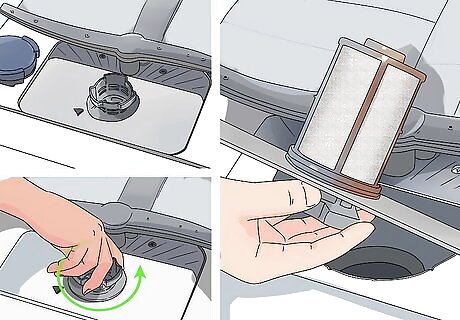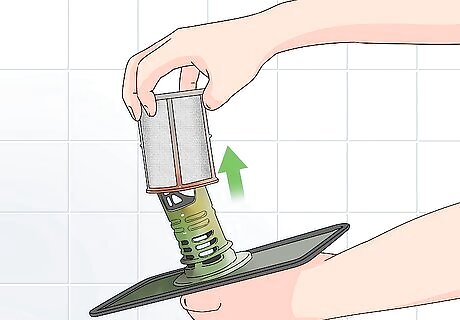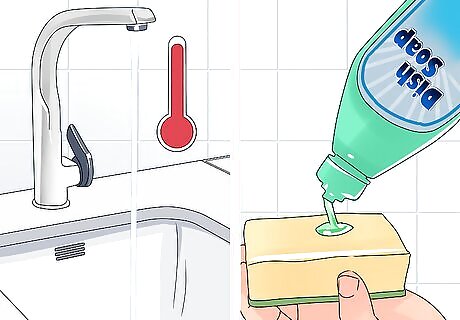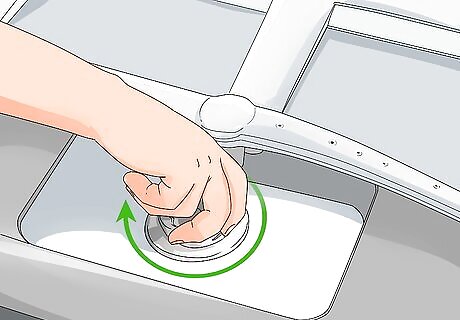
views
Removing the Dishwasher Filter

Move the bottom rack out of the dishwasher to uncover the filter. Open your dishwasher and pull the bottom dish rack out to uncover the back of the machine. You should see 3 things: a spray arm, a cylindrical filter, and a coarse mesh filter. The cylindrical and coarse mesh filters are the parts of the dishwasher you’ll need to clean. If the bottom rack is in your way, you can remove it from the dishwasher entirely. Be sure to take out any dishes that might be on the rack before you do this.Did you know? Many newer dishwashers come with self-cleaning filters, which don’t need nearly as much maintenance as manual filters. While they are a bit noisy, they don’t need to be cleaned every few months like manual filters. If you see a series of holes or plastic grid at the base of your machine, you have a self-cleaning filter.

Turn the cylindrical filter counter-clockwise and lift it straight up. Move the spray arm so that you can pull the cylindrical filter straight up without hitting your hand on the arm. Then, turn the cylindrical filter sharply to the left and lift it out of the dishwasher. If there is gunk built up on the filter, you’ll need to clean it thoroughly.Did you know? Another name for the cylindrical filter is fine mesh filter.

Slide the coarse filter out of its place in the dishwasher. This is a flat, U-shaped filter with a hole in the middle of it where the cylindrical filter goes. Slide it out of the dishwasher and check to see if there’s buildup on its surface. Once you’ve removed the 2 filters, place your hand in the hole where the cylindrical filter sits. That’s called the “sump”, and it might contain food particles or other gunk. If you feel anything in that hole, remove it immediately and throw it away.
Cleaning and Reinstalling the Dishwasher Filter

Turn on the faucet to get a stream of hot water. Leave the faucet running until the water is hot to the touch. While you’re waiting, put some dish soap on a damp sponge. Squeeze the sponge to spread the soap around. You can use warm water to clean your filter. However, the hotter the water, the more thorough the clean.

Scrub the gunk off the filter parts with a soap-covered sponge. Vigorously scrub both filters with the sponge. Clean both the inside and outside of the cylindrical filter and be sure to wipe away any gunk that has built up on either side of it. Then, scrub both sides of the flat, coarse filter to get rid of all the gunk on its surfaces. Depending on how much gunk has built up, you might need to use a separate sponge for each filter. This way, you won’t put any gunk back onto the filter.

Place the filters directly under the faucet to rinse them. This ensures you’ll remove every last bit of gunk on the filters. Make sure the water is hot and run each part of both filters under the stream. You don’t need to use a sponge for this step, as the water should remove the remaining gunk by itself.

Put the coarse mesh and cylindrical filter back in the dishwasher. Slide the coarse mesh filter into place first. The filter should sit flush in the dishwasher. Once the coarse mesh filter is in place, put the cylindrical filter in the hole and turn in clockwise to lock it back into place. You should hear a clicking sound when the cylindrical filter locks into place.Tip: Spin the spray arm to make sure it doesn’t hit the filter.

Perform this task every 3 months to keep your filter fresh. Manual filters need to be cleaned every few months to be at their best. Put a reminder in your phone to remove and clean the filter once every 3 months. Most dishwashers last around 10 years, so the filter doesn’t need to be replaced very often. If you clean it consistently, it will last for a decade or more. Someone manufacturers suggest cleaning your filter every 2-3 weeks. Check the owner’s manual to see what it says.Tip: To look up the owner’s manual online, look for a sticker inside the dishwasher. The sticker should be on the wall to the left of the dish racks. Google the model name on the sticker to bring up the owner’s manual.















Comments
0 comment